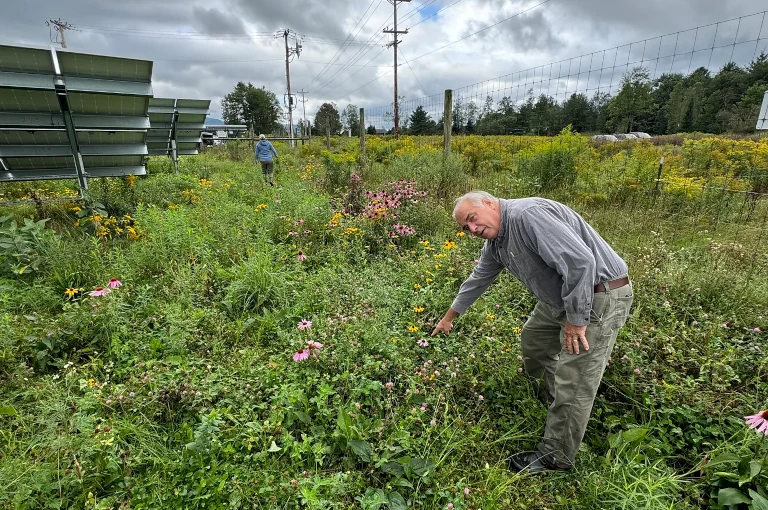Look, every column inch not spent writing about the rise of fascism in America is probably wasted—right now President Trump and his odious henchman Stephen Miller are trying to bait the people of Los Angeles into some kind of violent reaction, so they can swing public opinion back to their side on the issue of immigration. It’s sick, it’s calculated, and I’m not sure what do do about it except—and this could not be more important—remind you all to make sure everyone you know is signed up for No Kings Day next Saturday.
So in my impotence, I’m going to write about something else—a hopeful take on another crisis gripping the entire earth, one that threatens not democracies but kingdoms, in this case the insect kingdom.
First the crisis: new data indicates the ongoing collapse of insect populations around the world. Tess McLure has an invaluable piece in the Guardian that focuses on the work of legendary tropical biologist Dan Jantzen. In 1978—which is less than half a century ago—he was working at the Guanacaste Field Station in the forest of Costa Rica when one night he stretched out a bed sheet with a light behind it, and took pictures of what landed.
In that first photograph, taken in 1978, the lit-up sheet is so thickly studded with moths that in places the fabric is barely visible, transformed into what looks like densely patterned, crawling wallpaper.
Scientists identified an astonishing 3,000 species from that light trap, and the trajectory of Janzen’s career was transformed, from the study of seeds to a lifetime specialising in the forest’s barely documented populations of caterpillars and moths.
Now 86, Janzen still works in the same research hut in the Guanacaste conservation area, alongside his longtime collaborator, spouse and fellow ecologist, Winnie Hallwachs. But in the forest that surrounds them, something has changed. Trees that once crawled with insects lie uncannily still.
The hum of wild bees has faded, and leaves that should be chewed to the stem hang whole and un-nibbled. It is these glossy, untouched leaves that most spook Janzen and Hallwachs. They are more like a pristine greenhouse than a living ecosystem: a wilderness that has been fumigated and left sterile. Not a forest, but a museum.
Over the decades, Janzen has repeated his light traps, hanging the sheet, watching for what comes. Today, some moths flutter to the glow, but their numbers are far fewer.
“It’s the same sheet, with the same lights, in the same place, looking over the same vegetation. Same time of year, same time of the moon cycle, everything about it is identical,” he says. “There’s just no moths on that sheet.”
What’s uniquely scary about this account, as McLure makes clear, is not that insect populations are dwindling—we’ve known that for a long time, first from the work of citizen-entomologists in Germany and then in many other parts of the world. That steady decline—estimated at two percent a year, though some biologists think its higher—has largely been blamed on habitat loss and pesticide use. But in the case of Guanacaste, and other similar untouched forests, those things don’t apply. What we’re seeing is the steady effect of climate change. As Hallwachs explains,
A tropical forest ecosystem is “a finely tuned Swiss watch,” perfectly engineered to sustain a vastly biodiverse system of creatures.
Each element is delicately tuned and interlocks with the rest: the heat, the humidity, the rainfall, the unfolding of leaves, the length of the seasons, the start and stop of the life cycles of insects and animals.
With each incremental turn of one cog, the rest of the system responds. Insects and animals have evolved to time their hibernations and breeding times precisely to small signals from the system: a change in humidity, a lengthening of the light hours of the day, a small rise or fall in temperature.
But now, the system has one gear spinning wildly out of time: the climate.
“When I arrived here in 1963 the dry season was four months. Today, it is six months,” Janzen says. Insects that typically spend four months underground, waiting for the rains, are now forced to try to survive another two months of hot, dry weather. Many are not succeeding.
Alongside the changing seasons are other shifts, such as in rainfall or humidity. “It’s just a general disruption of all the little cues and synchronies that would be out there,” Janzen says. Across the entire clock of the forest, plants and creatures are falling out of sync. In the background, the temperature is rising.
“The killer – the cause that’s pulling the trigger – is actually water,” says Wagner. For insects, staying hydrated is a unique physiological challenge: rather than lungs, their bodies are riddled with holes, called spiracles, that carry oxygen directly into the tissue.
“They’re all surface area,” says Wagner. “Insects can’t hold water.” Even a brief drought lasting just a few days can wipe out millions of humidity-dependent insects.
This is by no means confined to the wet tropics. Researchers in lots of other areas—the hot desert southwest, for instance—are seeing the same things. Biologist David Wagner describes a recent trip to Texas, calling it “the most unsuccessful I’ve ever taken. There just wasn’t any insect life to speak of.”
It was not only the insects missing, he told McLure, it was…everything. “Everything was crispy, fried; the lizard numbers were down to the lowest numbers I can ever remember. And then the things that eat lizards were not present – I didn’t see a single snake the entire time.”
Particularly prominent in that sad list are birds. Just in this country, ornithologists at Cornell (the same people who brought you Merlin, and if you don’t have it on your phone why do you have a phone?) reported that America was missing about three billion birds—and about 2.9 billion of them, according to a subsequent study, were birds that depended on eating insects. (Which would explain why there may still be plenty of chickadees at your feeder).
So—and here begins the good news—you might not be surprised to learn how happy I was to read in PV magazine of another new study, this one from Germany, about how birds were thriving in the country’s growing number of solar arrays.
Biologist Matthias Stoefer said the high density of breeding larks in one of Germany’s largest solar parks in Brandenburg, north of Berlin, is astonishing. In his breeding territory mapping, he counted 178 spots within the solar park and surrounding areas. On average, there are 21 to 47 breeding pairs per 10 hectares. This is the highest lark density he has ever encountered. The reference area on a nearby field has only 33 spots, equivalent to 7.6 lark pairs per 10 hectares. Whether they can breed successfully there when the farmer sprays, fertilizes, and harvests throughout the summer is questionable, however.
The high numbers in the ground-mounted PV systems are also surprising because larks avoid vertical structures. The birds prefer open, wide landscapes away from forests and forest edges. However, the long photovoltaic rows with six modules stacked on top of each other do not seem to bother them. Instead, they benefit from the advantages of the location.
People rarely visit the fenced-in facility. The vegetation is kept short by sheep, which are currently lying in the sun with their lambs between the rows of modules. The sheep’s droppings and a changing selection of flowering herbs provide the birds with a varied insect buffet.
It’s not just larks who appreciate this. Right at the entrance to the solar park, a small bird, a wheatear, which is threatened with extinction in Germany, is bobbing on the edge of a module. During his monitoring two years ago, Stoefer discovered only one breeding pair. This year, he doesn’t have to search far.
Birds are learning, too. Initially nesting only at the edge or in surrounding compensation areas, they are increasingly migrating between the rows. White wagtails, corn buntings, whitethroats, red-backed shrikes, and yellow wagtails breed under solar roofs. In addition, there are bird species that are only there to forage or migratory birds, such as the red kite circling in the sky in search of mice and other small animals. Stoefer has observed a total of 17 different species.
If you’re wondering, skylarks are big-time insectivores, especially when they need protein for their young. I think it’s pretty clear what’s happening here: these solar fields are providing habitat for bugs, which in turn are providing dinner for birds. I think this is the case because I’ve watched it up close here in Vermont. Last summer, reporting for my new book, I spent time with a couple of neighbors, Mike and Tawnya Kiernan, who have set up a small non-profit business that grows plants that native pollinators like between the rows of 20 Vermont solar fields.
When the Kiernans are hired by a solar developer, it’s usually to plant on what was until recently a farm field; because the fields are typically monoculture and have been treated with pesticides for years, “the pollinator density is really low.” Mike uses a pollinator-counting method that involves walking on the margin of a field and counting wasps and flies and moths for seven and a half minutes. Then a random-number generator tells him which row of solar panels to walk along, and as he walks he counts the pollinators he sees in seven and a half minutes, then adds the two numbers together. “On those abandoned farm fields, we might get a count of forty or fifty in fifteen minutes,” Mike said. “But now, once we’ve done our thing, you can see ten at a glance. You can see three hundred in fifteen minutes.”
Insects that entomologists had assumed were extirpated from Vermont somehow sniffed out that the plants they liked had returned, and so did they.
“That’s Triepeolus pectoralis, a native, but one we rarely see! That’s only the tenth time it’s been seen in New England,” said Mike, as we ambled through a set of solar arrays next to a soccer field at a school in central Vermont. Next he was on his knees beside a particularly vibrant swamp milkweed. “That bluish-black wasp is a mud dauber,” he said. “He can catch a spider and keep it up on your rafters with a little bit of mud.” Pulling out his iPhone to take a picture, he added, “This bee with the red on his abdomen I’ve never seen before. Sometimes you need to get the male genitalia under a microscope to make an identification. You wouldn’t think so, but it’s really, really species-specific.”
Here’s the thing: to our untrained eye, a corn field looks more “natural” than an array of solar panels. But a corn field is a biological desert—basically there are no pollinators there at all (corn is self-pollinating) because they are sprayed with pesticides and herbicides. Put up some solar panels, and add some plants that only need to be mowed once a year or so (sometimes with sheep) and you see an explosion of life.
And—remember—those same solar panels are the only scaleable way we have of fighting the global heating that is now the biggest cause of insect decline.
Everything is falling apart in our world, but nature stands ready to give us a hand if we want it. Energy from the sun, funneled to panels that provide shade and cover for all kinds of life. (New data even shows solar farms in China are allowing desert soils to reform and stopping some of the giant dust storms that plague that country’s north).
There are thirty million acres of cornfield in the U.S. that are used for growing ethanol, and in the process providing about one percent of our energy needs. Scientists estimate those thirty million acres, covered in solar panels, would provide all the power the country requires.
Meanwhile we teargas protesters in Los Angeles and haul off men waiting for work outside Home Depot. We have so many good things we could be doing—that’s part of what breaks one’s heart.






